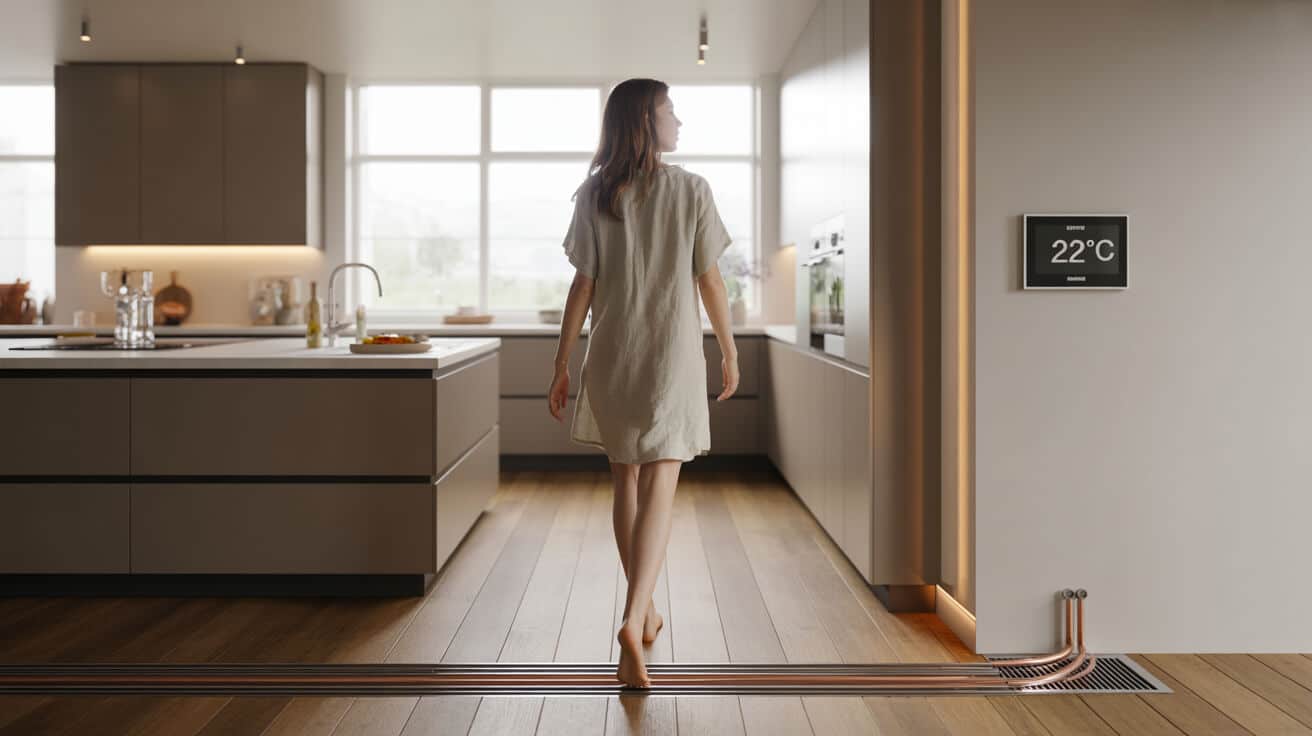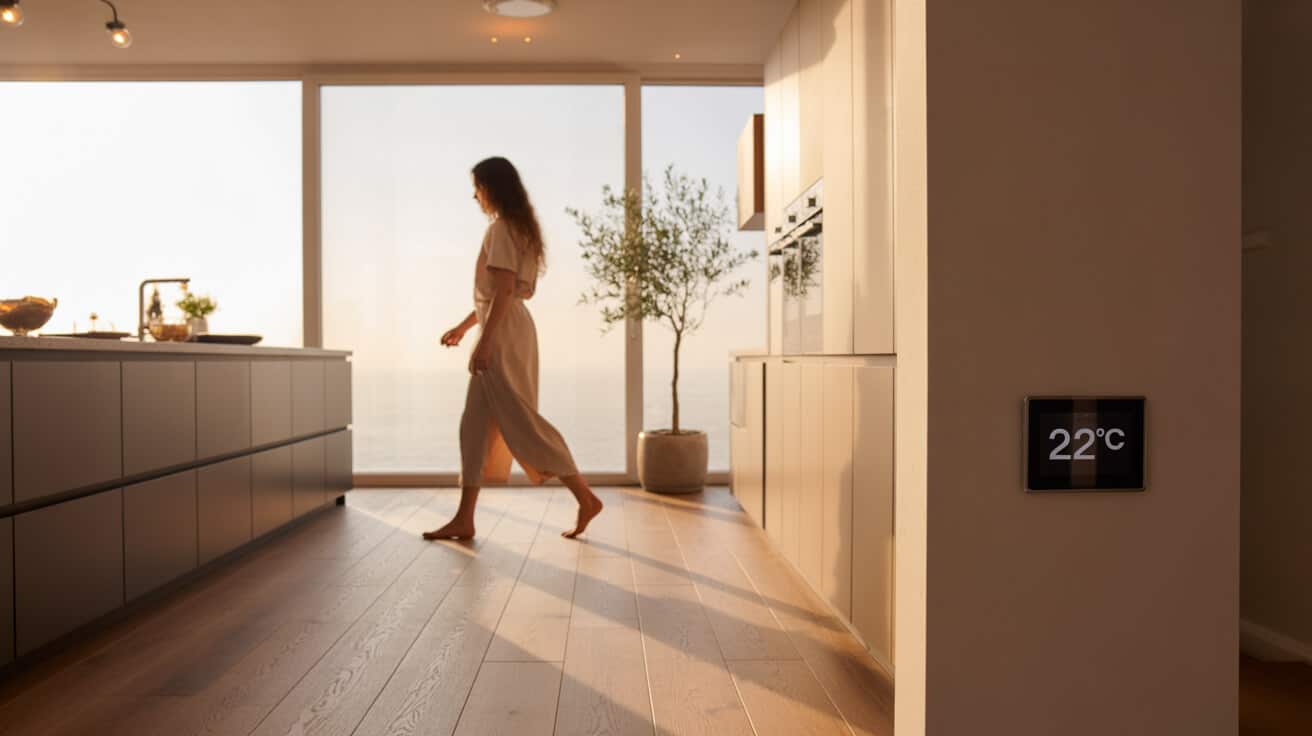Lead
Underfloor heating, encompassing both hydronic (water-based) and electric variants, distributes radiant heat through the floor structure, offering an alternative to traditional radiators or convectors. These systems are distinguished by their potential to operate at lower source temperatures and increased energy efficiency, particularly when installed to modern design standards with integrated smart controls and building fabric enhancements. Industry data and property case studies suggest that, under optimal conditions, underfloor heating not only delivers consistent warmth but also contributes to measurable reductions in long-term heating expenses for a wide array of property types.
Etymology or name origin
The phrase “underfloor heating” refers to mechanical or electrical systems placed beneath the floor’s surface, drawing from ancient designs such as the Roman hypocaust and the Korean ondol, which channelled heat beneath the living areas. Contemporary terminology has evolved to differentiate between electric mat/cable systems and water-based hydronic circuits, with technical definitions rooted in method of energy transfer, system response, and regulation.
Overview / context
Underfloor heating represents a marked shift from room edge or wall-mounted heating appliances, replacing convection-dominated warmth with extensive, low-temperature radiant coverage. This alteration of heat distribution fosters a climate in which entire floor surfaces emit warmth, resulting in reduced vertical temperature gradients and enhanced occupant comfort. The cost dynamics of these systems are shaped by insulation quality, control logic, heat source performance, and building typology. Users installing or commissioning underfloor heating are frequently motivated by rising utility costs, tightening regulatory performance obligations, and the pursuit of cleaner architectural lines within their spaces.
Adoption in the built environment
Residential uptake is prevalent in both newly constructed and refurbished homes, while commercial, hospitality, and healthcare sectors increasingly specify underfloor heating to meet compliance targets or lower operational bills. Market insights show increased adoption where property valuations, rental yields, or tenant satisfaction are directly influenced by perceptions of energy efficiency and comfort.
Stakeholder perspectives
- Homeowners: Prioritise comfort, aesthetic flexibility, and the promise of long-term energy savings.
- Landlords: Focus on regulatory compliance, minimal tenant complaints, and predictable operating costs.
- Facilities managers: Emphasise lifecycle costs, system reliability, and BMS (Building Management System) integration.
- Developers and public sector: Target EPC improvement, grant eligibility, and enhanced asset valuation.

History
Origins
Early forms of radiant floor heating can be traced to ancient civilizations, with the Roman hypocaust utilising subterranean flues to transfer combustion heat below slabs in communal baths and elite villas. Parallel technologies surfaced in East Asia, particularly the ondol system, as well as Persian designs that harnessed air and water for multi-room distribution.
Industrial emergence
Technological innovations in hydronic circulation pumps and synthetic pipework in the mid-20th century established underfloor heating’s practical viability for mass-market housing and commercial projects. The popularity of radiant heating grew in climates favouring slab-on-grade construction, where large, insulated floor surfaces could double as efficient thermal emitters.
Contemporary evolution
Integration with high-efficiency Condensing Boilers, solar and air/ground source heat pumps, and digital zone controls ensued. Policy advancements such as the UK’s Part L building regulations catalysed wider deployment, and specialist companies—like Plumbers 4U—rose to prominence by offering end-to-end lifecycle services from design to maintenance, ensuring both compliance and economic performance.
Concept / description
Basic principles
Underfloor heating systems deliver energy either via hydronic circuits—plastic pipes conveying heated water—or electric mats and cables arranged in loops beneath the floor finish. Heat is radiated upward, creating a uniform environment with lower air stratification and reduced cold spots. Thermal comfort can be sustained at lower air temperatures because the occupant’s whole-body exposure to radiant surfaces counteracts the sensation of chill.
Essential components
- Hydronic systems: PEX/PB pipework, manifold assemblies, zone actuators, mixing valves, variable-speed pumps, insulation, thermostats, temperature sensors, screed or dry floor systems.
- Electric systems: Heating cables or mats, programmable thermostats, insulation boards, responsive sensors, and rapid-cycle fusing or residual current protection.
- Common features: Floor probes for feedback, programmable wall units, BMS or smart device integration for adaptive scheduling.
Installation and layering
Typical installation involves substrate inspection and levelling, placement of vapour barriers, insulation layers, arrangement of pipes or mats with specified circuit spacing, screed or board encapsulation, and covering with the final floor finish. Hydronic systems require hydraulic balancing and air purging; electric systems demand insulation integrity and sensor calibration.
Functionality / purpose / applications
Heating distribution and comfort
By dispersing warmth across wide areas, underfloor systems produce a homogeneous temperature profile that avoids excessive air movement or dust, a feature cited for supporting respiratory comfort and allergy reduction. The absence of exposed emitters also reduces cleaning requirements and enables open-plan interior design.
Sectoral deployment
- Residential: Whole-house fit in new builds, targeted areas in retrofits (bathrooms, kitchens, extensions).
- Commercial and institutional: Office environments, hotels, care homes, schools—especially areas prioritising accessibility, hygiene, or comfort for vulnerable occupants.
- Industrial and specialised: Distribution in large, open-plan retail, light assembly, or gallery spaces where radiant coverage can offset wide temperature swings.
Additional use cases
Cost-saving strategies arise from low-temperature operation: pairing underfloor heating with efficient boilers, heat pumps, or renewable sources can increase seasonal coefficients of performance (SCOP), providing significant annual energy savings if properly designed.
Classifications / types / variants
Hydronic systems
Hydronic underfloor heating involves the circulation of warm water through circuits embedded in the floor, generally supplied by a condensing boiler or a heat pump. Advantages include compatibility with renewable sources, scalability, and low running costs over large spaces.
Electric systems
Electric underfloor systems use resistance cables or mats placed below the surface finish. These are often selected for localised heating due to their simplicity, suitable for renovation of existing rooms or small extensions. Operational costs are typically higher in bulk use, but rapid warm-up and minimal disruption for installation appeal in specific scenarios.
Hybrid and custom systems
Hybrid installations may pair hydronic slabs with electric mat boosters for fast preheat, or combine floor circuits with perimeter radiators in mixed-construction properties. Custom zoning, achieved via separate loops or mat circuits, permits individualised thermal control aligning with occupancy patterns and functional needs.

Systems / tools / methodologies
System controls
The proliferation of programmable and smart thermostats has enabled consumers and facilities managers to segment heating zones, optimise setpoints according to occupancy or time-of-day, and monitor energy use granularly. Smart controls often feature multi-room management, weather compensation (adjusting input based on ambient conditions), and learning algorithms that refine settings over time.
Specification and design tools
Property heat loss, insulation levels, and intended use guide system sizing. Modern software automates layout design, calculates optimal circuit lengths, and assigns control zones for balanced hydraulic or electrical loads. BMS integration enables advanced scheduling and energy reporting.
Maintenance procedures
Routine preventative maintenance for hydronic systems includes flushing to remove sludge, periodic actuator checks, pump and valve inspection, and validation of safety devices. Electric systems require less ongoing attention but should receive periodic resistance checks and control testing to prevent undetected faults.
Stakeholders / entities involved
End user groups
- Homeowners and tenants: seek comfort and utility bill savings.
- Landlords and letting agents: balance tenant satisfaction against compliance and repair risk.
- Facilities managers: monitor lifecycle costs and system integration with larger building controls.
Professional roles
- Heating and plumbing engineers: design, instal, and commission both new build and retrofit projects, with firms like Plumbers 4U providing specialist consultation and troubleshooting.
- Building service consultants: specify and oversee system integration into larger projects, often collaborating with insulation and energy assessors.
Regulatory bodies
WRAS and G3 set water quality and system standards; TrustMark and WaterSafe accredit technical quality. Local planning and building control departments approve plans and monitor construction for compliance.
Manufactures and distributors
Major entities (Nu-Heat, Uponor, Heatmiser, Warmup) provide component systems, warranty support, and technical documentation, aligning with national standards and supply chain traceability.
Legal / regulatory / ethical considerations
Building standards
Part L of UK Building Regulations prescribes minimum energy performance for heating; EPCs quantify operational efficiency for properties, influencing sale, rental, and grant eligibility. Noncompliance can result in enforcement actions and diminished asset value.
Certification requirements
Installers of unvented hydronic systems require G3 certification; adherence to WRAS approval for potable water connections is mandatory. Plumbers 4U and similar entities maintain compliance documentation and offer client guidance through certification procedures.
Subsidies and grants
government incentives such as ECO4 and BUS support capital investment in efficient low-carbon systems, conditional on performance audits and proof of professional installation. Eligibility is tied to the demonstration of reduced energy demands and proper system commissioning.
Performance metrics / data / measurements
Core operational metrics
Key technical and commercial indicators include:
| Performance Metric | Typical Value/Range | Units |
|---|---|---|
| Input water/cable temperature | 33–45 (hydronic), 25–35 (electric) | °C |
| Floor surface temperature | 24–29 | °C |
| Heat output | 50–150 | W/m² |
| Annual energy usage (insulated new build) | 30–50 | kWh/m²/yr |
| Control response time (hydronic) | 90–180 | minutes |
| System SCOP (with heat pump) | 3.0–4.5 | coefficient |
| EPC impact baseline improvement | up to +10 points | EPC/SAP |
Commissioning and system diagnostics
Properly commissioned systems provide documentation of circuit maps, balance readings, and controller locations. smart thermostats log historic and real-time data, assisting troubleshooting and warranty verification while allowing remote performance assessment for property managers.
Monitoring and energy analytics
Remote analytics platforms support facilities teams in energy benchmarking, comparative scheduling, and anomaly detection, facilitating early intervention and system tuning for optimal operation and cost mitigation.
Challenges / barriers / limitations
Technical and operational issues
Inadequate subfloor or perimeter insulation significantly undermines potential cost savings, leading to higher energy usage and uneven heating profiles. Incorrect circuit design or insufficient zoning can cause cold spots, slow response, and dissatisfied end users.
Installation costs for underfloor heating frequently exceed those of direct radiator replacement, deterring adoption in price-sensitive retrofits. Occupant inconvenience during works, especially in lived-in properties, can be a barrier to system upgrades.
Behavioural and systemic resistance
Perceptions—such as the idea that underfloor heating is incompatible with carpeted surfaces or unsuitable for older homes—may stem from earlier generations of products or incomplete understanding of modern technical advances. Mistrust or insufficient installer training can further erode confidence and long-term value realisation.
Impact / influence / legacy
Measurable energy and cost shifts
Well-designed and operated systems, especially under expert oversight, have demonstrated annual energy and running cost reductions of 10–30% relative to comparable radiator installations in new, well-insulated housing or commercial units. Tenants and owner-occupiers alike may experience enhanced comfort and control, supporting improved health and well-being.
Building codes and asset valuation
Requirements for low-carbon heating solutions now shape planning and development strategies. Enhanced EPC scores and eligibility for renewable energy grants drive increased investment, while local authority standards embed underfloor heating within social and affordable housing schemes.
Sector-wide effect
By facilitating regulatory compliance, operational cost reductions, and positive user experiences, underfloor heating has supported policy ambitions to reduce fuel poverty and carbon emissions. Companies providing credible, warranty-backed services reinforce sector trust and propel further adoption.
Future directions, cultural relevance, and design discourse
Technological innovation
Increased convergence between underfloor heating, AI-driven predictive control, dynamic energy tariff response, and renewable energy production is expected. Developments in modular overlay systems reduce installation time and disruptiveness, opening markets among existing housing stocks.
Regulatory evolution
Strengthening of EPC benchmarks, compulsory smart controls, and integration with municipal or district energy infrastructure represent the emerging regulatory landscape. Central and local government procurement increasingly mandates high-efficiency, professionally commissioned installations for new developments and public buildings.
Cultural emergence and comfort narratives
Societal expectations for comfort, cleanliness, and low operating expenditure continue to reshape the competitive environment for heating solutions. A cultural shift towards prioritising occupant experience and sustainable energy use reinforces the strategic position of underfloor heating within the broader evolution of domestic and commercial property management.

